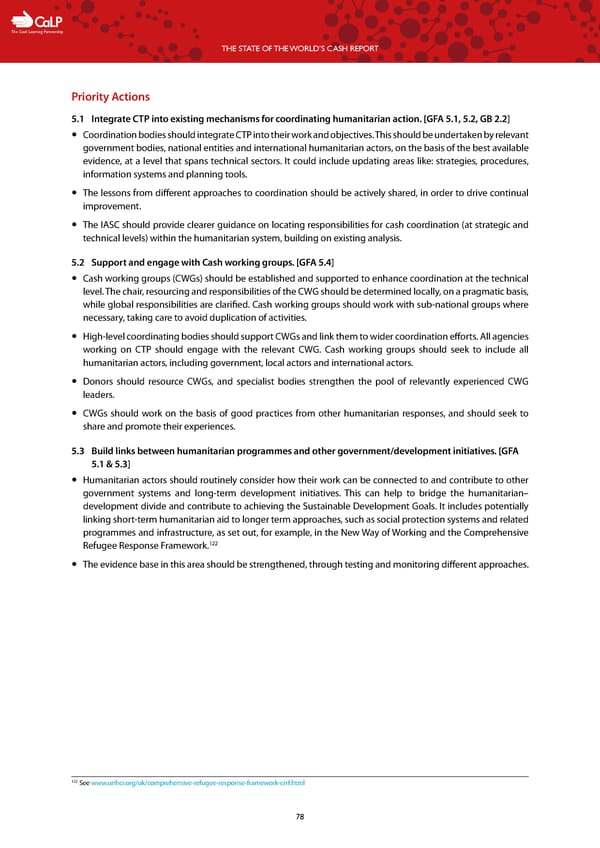C The Cash Learning Partnership THE STATE OF THE WORLD’S CASH REPORT Priority Actions 5.1 I ntegrate CTP into existing mechanisms for coordinating humanitarian action. [GFA 5.1, 5.2, GB 2.2] — Coordination bodies should integrate CTP into their work and objectives. This should be undertaken by relevant government bodies, national entities and international humanitarian actors, on the basis of the best available evidence, at a level that spans technical sectors. It could include updating areas like: strategies, procedures, information systems and planning tools. — The lessons from different approaches to coordination should be actively shared, in order to drive continual improvement. — The IASC should provide clearer guidance on locating responsibilities for cash coordination (at strategic and technical levels) within the humanitarian system, building on existing analysis. 5.2 Support and engage with Cash working groups. [GFA 5.4] — Cash working groups (CWGs) should be established and supported to enhance coordination at the technical level. The chair, resourcing and responsibilities of the CWG should be determined locally, on a pragmatic basis, while global responsibilities are clarified. Cash working groups should work with sub-national groups where necessary, taking care to avoid duplication of activities. — High-level coordinating bodies should support CWGs and link them to wider coordination efforts. All agencies working on CTP should engage with the relevant CWG. Cash working groups should seek to include all humanitarian actors, including government, local actors and international actors. — Donors should resource CWGs, and specialist bodies strengthen the pool of relevantly experienced CWG leaders. — CWGs should work on the basis of good practices from other humanitarian responses, and should seek to share and promote their experiences. 5.3 Build links bet ween humanitarian programmes and other government/development initiatives. [GFA 5.1 & 5.3] — Humanitarian actors should routinely consider how their work can be connected to and contribute to other government systems and long-term development initiatives. This can help to bridge the humanitarian– development divide and contribute to achieving the Sustainable Development Goals. It includes potentially linking short-term humanitarian aid to longer term approaches, such as social protection systems and related programmes and infrastructure, as set out, for example, in the New Way of Working and the Comprehensive 122 Refugee Response Framework. — The evidence base in this area should be strengthened, through testing and monitoring different approaches. 122 See www.unhcr.org/uk/comprehensive-refugee-response-framework-crrf.html 78
 The State of the World's Cash | Full Report Page 79 Page 81
The State of the World's Cash | Full Report Page 79 Page 81